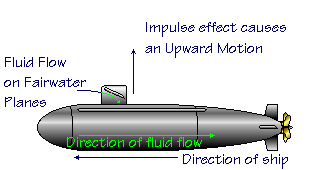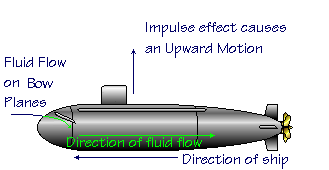 |
A submarine that is submerged functions very close to that of
an airplane. The principle parts of the submarine that control
its depth and heading are collectively reffered to as control
surfaces. The fairwater planes or bow planes,
the stern planes, and the rudder all control the
direction of the ship. The sail adds stability. As in an airplane,
in order for the control surfaces to work, the submarine must be
moving through the water. |
| In the example at right, the submarine is moving forward at a
given speed. If the Officer of the Deck (OOD) desires to make
the ship's depth shallow, one way of doing this is by going to
"rise" on the fairwater planes. This causes
the water to push on the underside of the planes and lift the
submarine to a more shallow depth. |
 |
 |
In the example at left, there are also the bow planes and
stern planes that can function the same way with a more
pronounced effect. Because the bow planes and stern
planes are further from the center of bouyancy, they have a
greater impact on the inclination of the ship -- and thus a larger
effect on the inclination/declination of the submarine. Normally,
both of these planes are operated together to achieve the desired
depth. |





